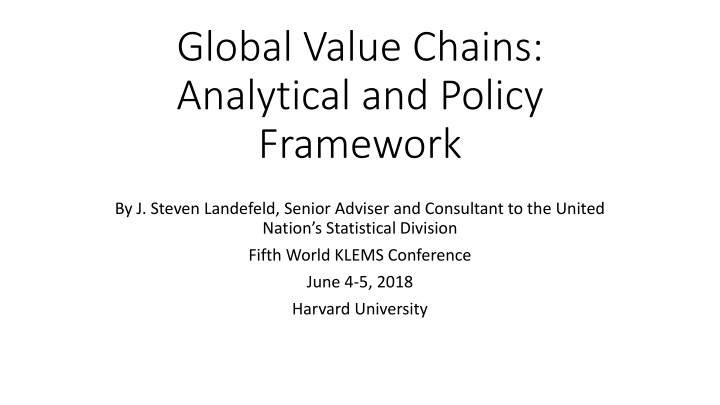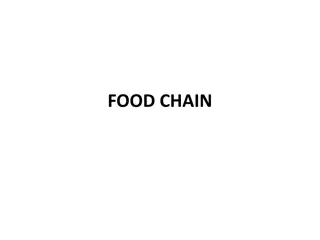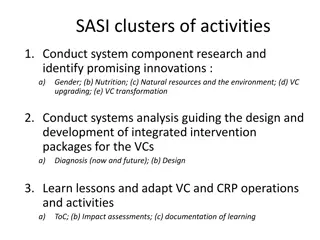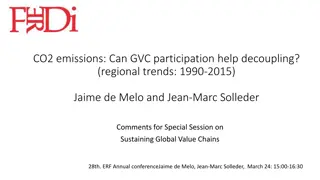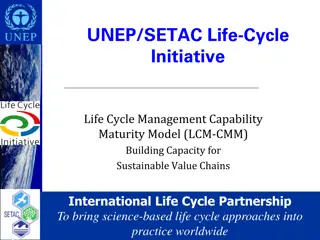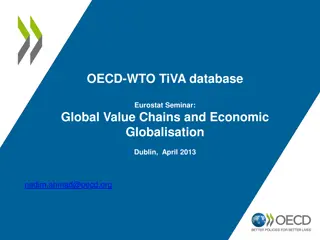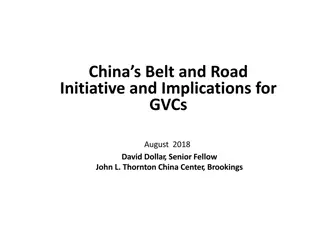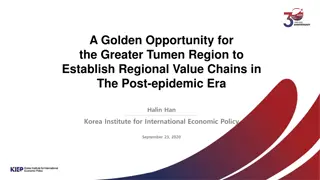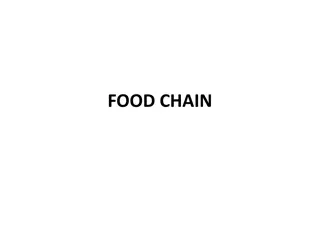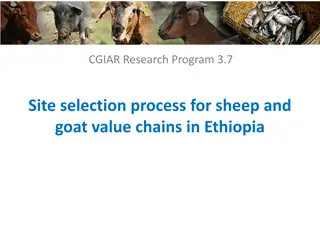Global Value Chains: Analytical and Policy Framework
This content discusses the analytical and policy framework of global value chains, focusing on topics such as gross vs. value-added trade, cross-border vs. ultimate creditor/debtor relationships, GVC satellite accounts, and policy perspectives including trade policies and tariffs. It delves into economic development policies, competitiveness, upgrading issues, and trade policy perspectives with real-world examples and data analysis. The content emphasizes the importance of understanding the complexities of modern value chains and their implications for international trade.
Download Presentation

Please find below an Image/Link to download the presentation.
The content on the website is provided AS IS for your information and personal use only. It may not be sold, licensed, or shared on other websites without obtaining consent from the author.If you encounter any issues during the download, it is possible that the publisher has removed the file from their server.
You are allowed to download the files provided on this website for personal or commercial use, subject to the condition that they are used lawfully. All files are the property of their respective owners.
The content on the website is provided AS IS for your information and personal use only. It may not be sold, licensed, or shared on other websites without obtaining consent from the author.
E N D
Presentation Transcript
Global Value Chains: Analytical and Policy Framework By J. Steven Landefeld, Senior Adviser and Consultant to the United Nation s Statistical Division Fifth World KLEMS Conference June 4-5, 2018 Harvard University
Cross-Boder vs. Ultimate Creditor/Debtor (UBO for FDI)
GVC Satellite Accounts Satellite Accounts Based on SNA BPM Indirect Estimates Using Global Input-Output Tables Trade in Value-Added Ulitimate Beneficial Owners and Creditors and Debtors Improved data through reconciliation, decomposition, and collection Complete set of national accounts Production, income, distribution of income, international transactions, prices, terms of trade, KLEMs, capital, and financial accounts
GVC Analytical and Policy Framework Economic Development Policy, Competitiveness, and Upgrading Policy Issues: Infrastructure Training/skills Education Niches/Gaps in Supply Chain Special tax, regulatory, zoning and other incentives Protective tariffs Detailed GVCs for key products especially well suited for development, competitiveness, and upgrading Probably also need GVC SUT cross-industry estimates for range of key products supplemented with extended SUT and other tables (for prioritizing and targeting policies/investments across industries)
GVC Analytical and Policy Framework: Trade Policy Perspective: Iphone (Only $6 of $500 Made in China accrues to China) U.S. China Bilateral Deficit (TIVA 30% lower/Bank of Italy 40%) Tariffs, Preferential and Multilateral Trade Agreements: Use of Extended SUT/GVC accouts vs. Bilateral Analysis 20% import adjustment tax for US: +$719 billion vs. -$214 billion, or from +3.7% vs. -1.1% of U.S. GDP. Direct + Indirect trade, plus price, efficiency, and terms of trade effects
Tariff Example: Cross Border Adjustment Tax U.S. Imports/Exports-substitution (+$719 billion, X and GDP) Impact of foreign content in U.S. exports (-$87 billion, X and GDP) Impact of U.S. content in U.S. imports (-$25 billion, X and GDP) Impact on MNE competitiveness and VA (-$138 billion, MNE VA and GDP) Terms of Trade (-$666 billion, one-time reduction in real GDI) MFP reduction (-$18 billion, GDP) Total Impact (-$214 billion vs. +$719 billion) or
GVC Analytical and Policy Framework: Trade Policy Tariffs, Preferential and Multilateral Trade Agreements: Use of extended world I-O shows reduction of even low U.S. E.U. tarrifs can produce significant gains. (Feenstra et. al 2017). Analysis of China-U.S. trade liberalization produces net job losses with bilateral data, but net job gains, mainly in services, using world I-O data. (Feenstra et al, 2016) Offshoring by MNE s lowers measured US GDP and Productivity by 0.25% and Value added in R&D intensive industries by 8% (Mataloni et al, 2017)
GVC Analytical and Policy Framework Tax Policy: Firm location By country, by industry, by size, by organizational structure, use of IT, Income and Financial Flows vs. Physical Location Short-Run vs. Long Run Effects ON Location and Financial Flows SR use of MNE tax saving by type (compensation, profits, saving, investment,..) LR impact on MNE Saving and Investment, Competitiveness, and Efficiency All require aggregate and detailed breakdowns Extended SUTs MNE operations data UBO FDI financial data
GVC Analytical and Policy Framework Monetary Policy: Risk assessment: U.S. Financial Crisis Regulation: Post-financial crisis Accurate measurement of inflation and productivity GVCs and challenges for price and output measurement All require aggregate and cross country data on: UBO, whom to whom, or ultimate creditor/debtor Cross-country MNE finance data to assess mobility of capital and possible response to regulatory changes Improved measures of GVC/international prices, quantities, and I-O coefficients
GVC Analytical and Policy Framework The Impact of Offshoring on Labor Markets and Welfare Trade flows Employment Compensation Distribution of Income All require extended SUT data in the aggregate, across industries, along with supplemental data on comensation, skills, etc. Evolving view of impact offshoring offered by extended SUTs and other data improvements
GVC Analytical and Policy Framework Environmental and Energy Policies Security Policies for Critical Materials, Food Safety, and National Security Both probably require some combination of broad extended SUT to set priorities, but focus likely to be more on product-specific GVCs.
